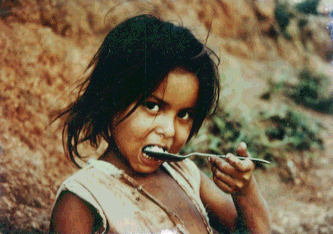In 1987 we were sitting at the bar of a small hotel in Managua, Nicaragua after having traveled some of the war zones in Northern Nicaragua. We had visited places like: Jinotega, San José de Bocay, Estelí and a few others. It had been a memorable trip already; we had witnessed the tragedy that was “Ronald Reagan’s contra war.” There was an ambush at one of our stops and the ensuing firefight resulted in eight casualties. All young ‘cachorros de Sandino’ or Sandino's cubs, youngsters, protectors of their people, protectors of their province, all of them in their teens. They brought them in from over the hill in a deuce and a half truck and laid them on canvases on the street to prepare for burial. There were screams and crying but somehow that evening there was a village celebration to welcome us.
Standing out above all else was the extreme poverty in which the children were forced to exist. Every attempt to progress in terms of building health clinics, schools, etc. was sabotaged by Reagan’s contras, with horrific consequences. We had been received with incredible hospitality and the people, particularly the women, exhibited remarkable resilience and strength. I clearly remember one of the town leaders of a settlement by the name of El Cua that offered us her testimony with tears in her eyes but never flinching as she continued to describe the deaths in her family, friends and neighbors. She like so many others would repeat the same message: “Go back and tell your people in the United States what’s happening here, tell your government to stop killing our children, we’re not a threat to anyone, all we want is our freedom.” In pretty much the same breath and great resolve some would say “¡aquí no se rinde nadie! Or, "Here no one surrenders!"
The people of these small, humble communities displayed great generosity. For having next to nothing, they would call their kids to help by going to the community hand mill to grind the corn that they had stashed in the corner of their dirt floored little hut so they could serve us a delicious meal of rice, beans and tortillas.
The children of these villages wore the only clothes they had to their name; some had no clothes at all. I remember a little girl who ran home to put on her dress, that’s right, the one and only dress she had. She returned promptly and proudly in her nice dress, no shoes, but she was proud of her dress. Distended bellies from malnutrition were common among these kids but so was their joy to serve us, their guests, food and drink. I have to mention another little girl that we picked up on the road who had been hiding after a contra attack. For several days and no food she had resorted to eating dirt and plants to survive. A beautiful little girl who reminded me of my own daughters back home, but her complexion had turned to grey and her hair had lost some of its pigmentation. We took her to the next village where there was a medical clinic, the shelves were empty of supplies but they promised to care for her as best they could. There were many memorable scenes like this, too many to recount here but there we were after our delegation's visit was about over. We sat there reflecting what we had just witnessed.
All of us were Veterans of U.S. wars, from WWII to Korea, Vietnam to the Grenada invasion, and we were sick of it. This propaganda of fighting for Freedom and Democracy was an intolerable farce being perpetrated on the American people and we knew it. On this delegation was my 'carnal' Nane Alejandres a man I met in Vietnam (interesting story later) and Phil Roettinger, former CIA officer. Our conscience was then challenged by one of our members; Duncan Murphy.
Duncan was a veteran of WWII where he had driven an ambulance and he brought the idea that we needed to do something about it. We couldn’t "just go home and forget about it," he told us. Bob Livesey from Boston and Gerry Condon from the bay area were the other part of our discussion, and the plan unfolded. We would bring what’s desperately needed to these children of Nicaragua, food, clothing, medical supplies, and vehicles for transportation. It would be an action that would involve hundreds of people. We all agreed to do our part begin to organize until we 'concretized' the plan as soon as we returned home. This was the spark that initiated what would come to be known as “The Veterans’ Peace Convoy to Nicaragua!”
Being the furthest South on the map and having a couple of acres in what used to be country back then, I agreed that everyone should converge at my home. Never suspecting that in June of 1988 I would be having over 150 people from all over the country as overnight guests. That was the beginning of one of the significant actions that opposed the genocide being perpetrated by the Reagan administration. Our slogan was to be: “Feed the Children not the War!”
to be continued
